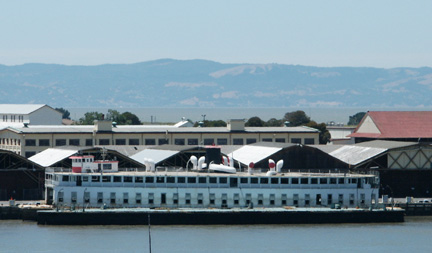Ferry For Sale
 Launched
as the Fresno in 1927, the Willapa started life as a San
Francisco Bay company for the Southern Pacific Railroad
ferry system.
Launched
as the Fresno in 1927, the Willapa started life as a San
Francisco Bay company for the Southern Pacific Railroad
ferry system.
After plying San Francisco waters for over
ten years, the new bridges over the Bay all but effectively
ended ferry service across San Francisco Bay. Puget Sound
Navigation, nearly always on the hunt for more vessels,
purchased all six of the Steel Electric ferries from
Southern Pacific to bolster their fleet and improve service.
Starting in August of 1940, the ferries began traveling
northward in twos. After the Fresno and Santa Rosa arrived,
two others, the Mendocino and Lake Tahoe, were nearly lost
en route during a December storm. PSN waited until spring to
bring the last of the ferries, including by this time the
City of Sacramento, the Shasta, San Mateo, and Napa Valley (Malahat)
to Puget Sound.
The ferries immediately went into the yard
at Eagle Harbor to be specially configured for the Bremerton
run. Traffic on the route had increased, and although it
wasn’t known at the time, with WWII about to start, the
route would be like her near sister Enetai, the Willapa was
extensively rebuilt. One wheelhouse removed. One rudder was
welded into place, and the propeller removed. Her New London
diesel-electric engines were removed and were replaced with
one direct-drive Busch-Sulzer diesel, which gave both the
Willapa and Enetai a speed of about 15 knots.
Her interior was expanded and the
passenger cabin lengthened to the ends of the promanade
deck. The wooden benches were removed, replaced by plushly
padded, longer bench seats similar to those on the Kalakala.
Both the Willapa and Enetai were intended to haul people:
their passenger carring capacity increased from around 800
to nearly 1200.
The Willapa liked her new route; she
didn’t leave the Bremerton run for nearly 25 years. During
her many years on the run, her compainions were the silvery
Kalakala, the distingushed former Great Lakes steamer
Chippewa, and her sister Enetai. During the war years, two
other ferries joined the route, the steamers Malahat and
City of Sacramento.
After the war and the transfer to
Washington State Ferries, the Willapa changed little in
appearance. Like the others in the Steel Electric Class
(which technically neither the Willapa or Enetai belonged to
any more, having had their power plants changed), the large
windows on the car deck from the San Francisco Bay days were
welded in and replaced by open, round portholes.
Her conversion to a single-ended ferry by
Black Ball was to spell the end of her service on Puget
Sound. Initially, the Bremerton dock could only handle a
single-ended ferry. By the 1960s, that was no longer true,
and in addition, the aging Busch-Sulzer diesels were
expensive to run and maintain. With the new Super Class
ferries on the horizon, it was decided that after the first
new ferry arrived, some of the most expensive to run vessels
would be retired. When the Hyak arrived, the Kalakala and
Willapa were put out of a job, both a victims of their high
operating costs, low car carrying capacity, and speed. The
Hyak could make ten trips to the Willapa’s five.
Eventually sold and returned to the Bay
Area under her old name of Fresno, the classic Willapa/Fresno
remains there today, slowly being restored by Cable Car
Charters. She is now for sale, with the passing of Arnold
Gridley (owner of Cable Car Charters). She is currently
docked at Mare Island, Vallejo, and is available for sale
along with the hull of another San Francisco Ferry the San
Leandro. For price and information on purchasing the Ferry,
contact Terry F. Koenig, Koenig & Associates (415) 726-3712.